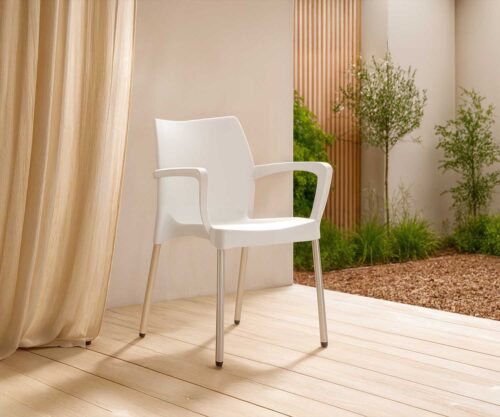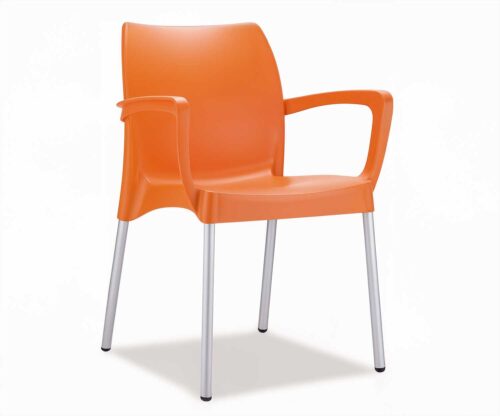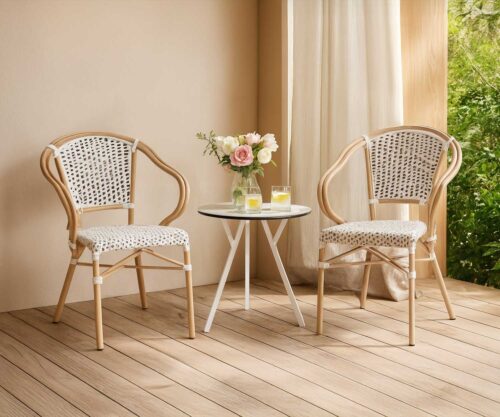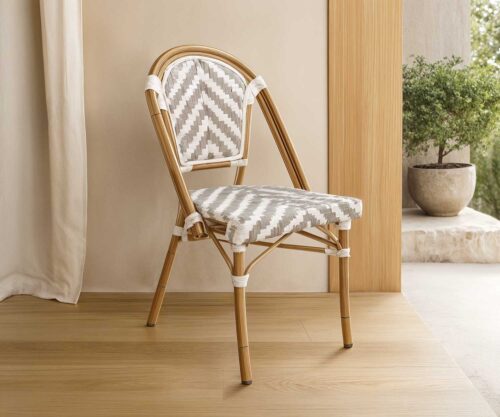Aged Care Outdoor Furniture and Designing Outdoor Spaces for the Elderly in Australia

Designing outdoor spaces in aged care and retirement living communities is about much more than adding a few garden chairs. In Australia, the Aged Care Quality Standards, particularly Standard 5 – Organisation’s Service Environment, emphasise that the environment must be safe, comfortable, and support a resident’s independence, function, and enjoyment. Outdoor areas play a crucial role in achieving this.
Well-designed outdoor spaces, complete with fit-for-purpose aged care outdoor furniture, help reduce depression, stress, falls, and vitamin D deficiency. Research such as Kaplan’s work on restorative environments highlights the healing benefits of nature. For facility managers and operators, the challenge is ensuring outdoor spaces meet the needs of elderly residents while complying with aged care legislation and safety requirements.
Below, we’ll explore the five most common barriers to using outdoor spaces in aged care and retirement living settings — and how thoughtful design, furniture selection, and planning can overcome them.
1. Designing Outdoor Spaces for Comfort and Independence
The design of aged care outdoor spaces directly affects how often and how comfortably residents use them. Seating, greenery, pathways, and shelter are the foundations of success.
-
Seating: Sitting in well-designed aged care outdoor furniture is one of the most common activities outdoors. Chairs should be sturdy, weather-resistant (e.g., UV-stabilised polypropylene reinforced with glass fibre), and designed to support independent sit-to-stand transitions with correct seat height, depth, and armrests. Poor chair design can reduce mobility, social interaction, and even nutrition intake if residents avoid communal dining outdoors. Placing seating at regular intervals along paths makes spaces more accessible.
-
Garden greenery: Plants, trees, and flowers enhance wellbeing by engaging the senses — touch, smell, and sight. Seeing wildlife or walking among trees improves mood and provides natural talking points for social interaction.
-
Pathways: Safe pathways should be smooth, slip-resistant, wide enough for mobility aids, and free of steep slopes. For people living with dementia, looped pathways that bring residents back to a familiar point reduce disorientation. Contrasting colours or raised edging assist with wayfinding and safety.
2. Removing Building Barriers to Outdoor Access
Even the best outdoor area is useless if residents can’t easily get there. Many Australian aged care facilities face barriers like high door thresholds, heavy manual doors, or long distances from living areas.
-
Install automatic doors instead of heavy manual doors for easier access with wheelchairs or walkers.
-
Ensure ground-level access where possible; residents living on higher floors should have equitable outdoor access through lifts designed for mobility aids.
-
Position gardens and outdoor courtyards close to common areas so residents feel encouraged to step outside regularly.
3. Prioritising Safety in Outdoor Aged Care Design
Safety is often the deciding factor in whether an outdoor area is used regularly. Staff need reassurance that residents can enjoy the outdoors without constant supervision, while residents need confidence that they won’t fall or get lost.
-
Outdoor paths should be level, slip-resistant, low-glare, and shaded to prevent discomfort in the Australian sun.
-
Fit-for-purpose outdoor furniture must be strong, well-maintained, and resistant to harsh weather conditions.
-
Gardens for residents with dementia should include secure 1.8m fencing and discreet exits to reduce wandering risks.
-
Plants should be non-toxic and free from trip hazards.
-
Ensure staff can visually observe outdoor spaces from inside to balance independence with safety oversight.
4. Providing Shelter for All-Weather Use
Australian weather presents unique challenges for aged care outdoor spaces. From extreme summer heat to cool winter winds, poorly designed areas will sit empty for much of the year.
-
Provide shaded seating areas with awnings, pergolas, or large umbrellas to protect against UV exposure.
-
Incorporate heated or sheltered outdoor areas to encourage year-round use.
-
Create transitional spaces, such as verandas, that allow residents’ eyes to adjust gradually from indoors to outdoors.
By designing with weather in mind, facilities can turn outdoor areas into true living spaces rather than seasonal add-ons.
5. Encouraging Social Interaction Outdoors
Outdoor spaces should support not just physical health but also social and emotional wellbeing. Residents thrive when spaces foster connection, conversation, and activity.
-
Arrange outdoor furniture in groupings that encourage interaction, such as small clusters for conversation or long tables for family meals.
-
Add interactive garden features like men’s sheds, flower beds, bird baths, or child-friendly areas to engage residents, families, and visitors.
-
Provide quiet nooks alongside communal zones, giving residents the choice between socialising and enjoying solitude.
Social activities outdoors can improve a resident’s sense of belonging, reduce loneliness, and strengthen community within aged care facilities.
Why Outdoor Furniture Matters in Aged Care
The choice of aged care outdoor furniture is more than an aesthetic decision — it directly impacts safety, independence, and quality of life. Fit-for-purpose seating that balances comfort, durability, and accessibility ensures equity for residents with varying mobility levels. Seat height, depth, and supportive armrests can mean the difference between a resident needing assistance or feeling empowered to move independently.
At FHG, our Project Consultants work with aged care providers across Australia to design and deliver furniture solutions tailored to each facility’s needs. From weather-resistant armchairs to accessible dining settings, we manufacture outdoor furniture that balances comfort, safety, and compliance with the Aged Care Quality Standards.
Final Word
Creating outdoor spaces that residents love and use daily requires more than planting trees or adding a few benches. It takes thoughtful design, safe and durable furniture, and an understanding of the unique needs of older Australians. By addressing barriers like access, safety, shelter, and socialisation, aged care facilities can transform outdoor spaces into vital extensions of daily life.
👉 Looking to upgrade your aged care outdoor furniture? Speak with an FHG Project Consultant today and discover how we can help you create outdoor spaces that enhance wellbeing, independence, and compliance.
Durable Outdoor Furniture Designed with the Australian Climate in Mind
More News
Aged Care Outdoor Furniture and Designing Outdoor Spaces for the Elderly in Australia

Designing outdoor spaces in aged care and retirement living communities is about much more than adding a few garden chairs. In Australia, the Aged Care Quality Standards, particularly Standard 5 – Organisation’s Service Environment, emphasise that the environment must be safe, comfortable, and support a resident’s independence, function, and enjoyment. Outdoor areas play a crucial role in achieving this.
Well-designed outdoor spaces, complete with fit-for-purpose aged care outdoor furniture, help reduce depression, stress, falls, and vitamin D deficiency. Research such as Kaplan’s work on restorative environments highlights the healing benefits of nature. For facility managers and operators, the challenge is ensuring outdoor spaces meet the needs of elderly residents while complying with aged care legislation and safety requirements.
Below, we’ll explore the five most common barriers to using outdoor spaces in aged care and retirement living settings — and how thoughtful design, furniture selection, and planning can overcome them.
1. Designing Outdoor Spaces for Comfort and Independence
The design of aged care outdoor spaces directly affects how often and how comfortably residents use them. Seating, greenery, pathways, and shelter are the foundations of success.
-
Seating: Sitting in well-designed aged care outdoor furniture is one of the most common activities outdoors. Chairs should be sturdy, weather-resistant (e.g., UV-stabilised polypropylene reinforced with glass fibre), and designed to support independent sit-to-stand transitions with correct seat height, depth, and armrests. Poor chair design can reduce mobility, social interaction, and even nutrition intake if residents avoid communal dining outdoors. Placing seating at regular intervals along paths makes spaces more accessible.
-
Garden greenery: Plants, trees, and flowers enhance wellbeing by engaging the senses — touch, smell, and sight. Seeing wildlife or walking among trees improves mood and provides natural talking points for social interaction.
-
Pathways: Safe pathways should be smooth, slip-resistant, wide enough for mobility aids, and free of steep slopes. For people living with dementia, looped pathways that bring residents back to a familiar point reduce disorientation. Contrasting colours or raised edging assist with wayfinding and safety.
2. Removing Building Barriers to Outdoor Access
Even the best outdoor area is useless if residents can’t easily get there. Many Australian aged care facilities face barriers like high door thresholds, heavy manual doors, or long distances from living areas.
-
Install automatic doors instead of heavy manual doors for easier access with wheelchairs or walkers.
-
Ensure ground-level access where possible; residents living on higher floors should have equitable outdoor access through lifts designed for mobility aids.
-
Position gardens and outdoor courtyards close to common areas so residents feel encouraged to step outside regularly.
3. Prioritising Safety in Outdoor Aged Care Design
Safety is often the deciding factor in whether an outdoor area is used regularly. Staff need reassurance that residents can enjoy the outdoors without constant supervision, while residents need confidence that they won’t fall or get lost.
-
Outdoor paths should be level, slip-resistant, low-glare, and shaded to prevent discomfort in the Australian sun.
-
Fit-for-purpose outdoor furniture must be strong, well-maintained, and resistant to harsh weather conditions.
-
Gardens for residents with dementia should include secure 1.8m fencing and discreet exits to reduce wandering risks.
-
Plants should be non-toxic and free from trip hazards.
-
Ensure staff can visually observe outdoor spaces from inside to balance independence with safety oversight.
4. Providing Shelter for All-Weather Use
Australian weather presents unique challenges for aged care outdoor spaces. From extreme summer heat to cool winter winds, poorly designed areas will sit empty for much of the year.
-
Provide shaded seating areas with awnings, pergolas, or large umbrellas to protect against UV exposure.
-
Incorporate heated or sheltered outdoor areas to encourage year-round use.
-
Create transitional spaces, such as verandas, that allow residents’ eyes to adjust gradually from indoors to outdoors.
By designing with weather in mind, facilities can turn outdoor areas into true living spaces rather than seasonal add-ons.
5. Encouraging Social Interaction Outdoors
Outdoor spaces should support not just physical health but also social and emotional wellbeing. Residents thrive when spaces foster connection, conversation, and activity.
-
Arrange outdoor furniture in groupings that encourage interaction, such as small clusters for conversation or long tables for family meals.
-
Add interactive garden features like men’s sheds, flower beds, bird baths, or child-friendly areas to engage residents, families, and visitors.
-
Provide quiet nooks alongside communal zones, giving residents the choice between socialising and enjoying solitude.
Social activities outdoors can improve a resident’s sense of belonging, reduce loneliness, and strengthen community within aged care facilities.
Why Outdoor Furniture Matters in Aged Care
The choice of aged care outdoor furniture is more than an aesthetic decision — it directly impacts safety, independence, and quality of life. Fit-for-purpose seating that balances comfort, durability, and accessibility ensures equity for residents with varying mobility levels. Seat height, depth, and supportive armrests can mean the difference between a resident needing assistance or feeling empowered to move independently.
At FHG, our Project Consultants work with aged care providers across Australia to design and deliver furniture solutions tailored to each facility’s needs. From weather-resistant armchairs to accessible dining settings, we manufacture outdoor furniture that balances comfort, safety, and compliance with the Aged Care Quality Standards.
Final Word
Creating outdoor spaces that residents love and use daily requires more than planting trees or adding a few benches. It takes thoughtful design, safe and durable furniture, and an understanding of the unique needs of older Australians. By addressing barriers like access, safety, shelter, and socialisation, aged care facilities can transform outdoor spaces into vital extensions of daily life.
👉 Looking to upgrade your aged care outdoor furniture? Speak with an FHG Project Consultant today and discover how we can help you create outdoor spaces that enhance wellbeing, independence, and compliance.
Durable Outdoor Furniture Designed with the Australian Climate in Mind
Commercial furniture by room
Based in Brisbane, we’re an Australian manufacturer of aged care furniture, retirement living furniture, hospital & healthcare furniture, hotel & accommodation furniture and student accommodation furniture. We also supply a range of commercial office furniture.
Discover the FHG Look Book: Your Source of Inspiration for Quality Australian-Made Commercial Furniture
- Quality Craftsmanship: See why we’ve been a trusted partner for over 25 years.
- Local Excellence: Learn how our Brisbane team ensures the highest standards.
- Inspiration and Ideas: Find innovative furniture solutions for any environment.
Don’t miss the opportunity to transform your commercial space with FHG’s expertly crafted furniture. Download the FHG Look Book today and start your journey towards exceptional design and quality.




























